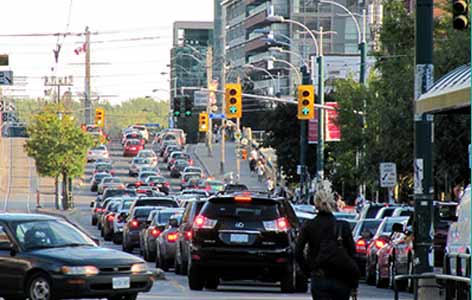Home page Description:
Studying the movement of ants gives insight towards reducing traffic congestion in major cities
Posted On: September 23, 2016

Image Caption:
Toronto traffic jam on Spadina Ave.
By Michael Chang, ORT Science Writer and UHN Research Trainee
Humans seem to be inept at efficiently organizing multidirectional traffic; for proof, take the 5:00 pm UHN shuttle.
Ants, by contrast, are exceptional at organizing multidirectional traffic, as seen during their foraging expeditions for resources. Ants may be superior at regulating multidirectional traffic flow for two major reasons. Firstly, the ants are all from the same colony, sharing common objectives and actively working together to achieve them. For humans, however, the collective movement of pedestrians or motorists is an amalgamation of numerous individual goals in contest with one another on shared roads. Secondly, ants have innate right-of-way priority rules and share information with one another about available optimal routes, via pheromones and physical contact, to maintain smooth traffic flow. In stark contrast, human motorists are known to sporadically disobey traffic rules and cause accidents that contribute further to traffic congestion.
In the future, we may be able to implement similar strategies of traffic regulation used by ants, as we strive for a society that is free of traffic jams. The development of cars equipped with Wi-Fi, GPS navigation with traffic updates, and, recently, the self-driving car all set the platform for centralized and decentralized systems of traffic regulation. Centralized systems can integrate objectives and assign routes to self-driving cars based on distance, traffic conditions, and the active routes of other cars. The development of dynamic road lanes and adaptive traffic lights can be connected with centralized systems to accommodate cars en route. Additionally, a decentralized re-routing algorithm within each car can operate concomitantly to avoid local traffic jams based on shared information from nearby cars. These visions for future traffic regulation will help maximize the use of available road infrastructure, and hopefully, make “traffic jams” as outlandish as manually rolling down car windows with “crank handles”.
Humans seem to be inept at efficiently organizing multidirectional traffic; for proof, take the 5:00 pm UHN shuttle.
Ants, by contrast, are exceptional at organizing multidirectional traffic, as seen during their foraging expeditions for resources. Ants may be superior at regulating multidirectional traffic flow for two major reasons. Firstly, the ants are all from the same colony, sharing common objectives and actively working together to achieve them. For humans, however, the collective movement of pedestrians or motorists is an amalgamation of numerous individual goals in contest with one another on shared roads. Secondly, ants have innate right-of-way priority rules and share information with one another about available optimal routes, via pheromones and physical contact, to maintain smooth traffic flow. In stark contrast, human motorists are known to sporadically disobey traffic rules and cause accidents that contribute further to traffic congestion.
In the future, we may be able to implement similar strategies of traffic regulation used by ants, as we strive for a society that is free of traffic jams. The development of cars equipped with Wi-Fi, GPS navigation with traffic updates, and, recently, the self-driving car all set the platform for centralized and decentralized systems of traffic regulation. Centralized systems can integrate objectives and assign routes to self-driving cars based on distance, traffic conditions, and the active routes of other cars. The development of dynamic road lanes and adaptive traffic lights can be connected with centralized systems to accommodate cars en route. Additionally, a decentralized re-routing algorithm within each car can operate concomitantly to avoid local traffic jams based on shared information from nearby cars. These visions for future traffic regulation will help maximize the use of available road infrastructure, and hopefully, make “traffic jams” as outlandish as manually rolling down car windows with “crank handles”.




